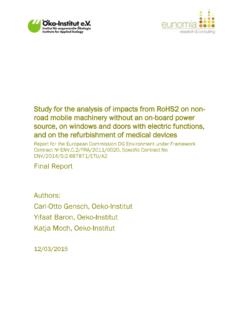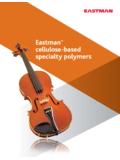Transcription of 1st Stakeholder Consultation – Compilation of initial ...
1 Study to support the review of the list of restricted substances and to assess a new exemption request under RoHS 2 (Pack 15). 1st Stakeholder Consultation Compilation of initial substance information for diantimony trioxide (CAS 1309-64-4; EC 215-175-0). Abbreviations BAUA German Federal Institute for Occupational Safety and Health CLP Regulation (EC) No 1272/2008 on Classification, Labelling and Packaging CoRAP Community Rolling Action Plan ECHA European Chemical Agency ESIA European Semiconductor Industry Association HBCDD Hexabromocyclododecane HIPS High Impact Polystyrene PET Poly Ethylene Terephthalate REACH Regulation (EU) No 1907/2006 on the Registration, Evaluation, Authorisation and restriction of Chemical substances TBBP-A Tetrabrombisphenol A. US EPA United States Environmental Protection Agency 1. Legal status and other restrictions Diantimony trioxide is classified under the CLP regulation as Carc.
2 2 - H351 (Suspected of causing cancer via inhalation). 1. Diantimony trioxide was included in the Community Rolling Action Plan (CoRAP) by the German Federal Institute for Occupational Safety and Health (BAUA). The substance evaluation has not started yet, but is scheduled for 2018. As initial grounds for concern for the substance, the following short list is published on the ECHA website: 2. Carcinogenic;. Exposure of workers;. High (aggregated) tonnage;. High risk characterisation ratio (RCR) for dermal and inhalation exposure;. Other exposure/risk based concern;. Wide dispersive use. 1. , last viewed 2. /dislist/details/0b0236e180b91312, last viewed Study to support the review of the list of restricted substances and to assess a new exemption request under RoHS 2 (Pack 15). Antimony and its compounds are subject to a number of regulations: Regarding environmental issues: The IED Directive 2010/75/EU on industrial emissions (integrated pollution prevention and control).
3 Sets emission limit values for antimony and its compounds at industrial sites. 3. In the Water Framework Directive 2006/11/EC on pollution caused by certain dangerous substances discharged into the aquatic environment of the Community, antimony is listed as a substance for which water pollution has to be reduced. Member States are therefore required to establish environmental quality standards for this purpose. Any compound of antimony is characterized as a heavy metal and leads to a classification as hazardous waste according to Commission Decision 2000/532/EC establishing a list of hazardous waste pursuant to Article 1(4) of Council Directive 91/689/EEC on hazardous waste. Limit values for antimony are set by Council Decision of 19 December 2002 establishing criteria and procedures for the acceptance of waste at landfills pursuant to Article 16 of and Annex II of Directive 1999/31/EC (2003/33/EC).
4 4. Maximum air emission limit values for the incineration of waste are established in the Directive 2000/76/EEC on the incineration of waste. 5. Regarding human health issues, A migration limit of antimony trioxide is set for plastics used in contact with foodstuffs by Commission Directive 2002/72/EC relating to plastic materials and articles intended to come into contact with foodstuffs. 6. for toys or components of toys by Directive 2009/48/EC on the safety of toys. 7. A maximum level for antimony is set for water intended for human consumption by the Council Directive 98/83/EC on the quality of water for human consumption. 8. There was a proposal for community-wide measures to reduce risks, submitted by the Swedish Chemicals Agency in 2008. 9 The proposal recommended establishing occupational exposure limit values for antimony trioxide according to Directive 98/24/EEC.
5 Occupational exposure limits of mg/m antimony trioxide on average have been established in several EU countries. 3 3. Average emission limit values (mg/Nm ) for the following heavy metals over a sampling period of a minimum of 30 minutes and a maximum of 8 hours: 0,5 for Antimony and its compounds, expressed as antimony (Sb). 4. Leaching limit values for waste acceptable at landfills for inert waste and limit values for non-hazardous waste, see: :L:2003:011:0027:0049:EN:PDF, last viewed 5 3. All average values over the sample period of a minimum of 30 minutes and a maximum of 8 hours: total 0,5 mg/m and total 3. 1 mg/m for Antimony and its compounds, expressed as antimony (Sb). 6. Specific migration limit SML = 0,02 mg/kg (expressed as Antimonium and analytical tolerance included). 7. Migration limits in dry, brittle, powder-like or pliable toy material: 45 mg/kg Antimony in liquid or sticky toy material: 11,3 mg/kg Antimony in scraped-off toy material: 560 mg/kg Antimony 5,0 g/l Antimony 8.
6 9. Swedish Chemicals Agency (2008): Proposal for Community-wide measures to reduce risks; Diantimony Trioxide; 2008-11- 26; , last viewed 2/6. Study to support the review of the list of restricted substances and to assess a new exemption request under RoHS 2 (Pack 15). Antimony is listed on the 2017 list of Critical Raw Materials for the EU (COM(2017) 490 final) 10. Materials appearing on this list have been identified as critical for the EU because possible risks of supply shortage (scarcity) and their impacts on the economy are higher than those of most of the other raw materials. Additional aspects ( environmental, social) are not mentioned in the communication in this regard. 2. Uses and quantities Antimony trioxide is registered under REACH, indicating a volume of more than 10,000 tonnes per year. 11 The following industrial uses are indicated: Flame retardants.
7 Manufacture of flame retarded textiles;. In the plastics and rubber industry;. In the production of glass, enamels, functional ceramics and semi-conductors;. In the production of pigments, paints, coatings, ceramics, brake pads and production and formulation of fine chemicals;. In wood adhesives;. As a flame retardant additive;. Use in pigments;. In PET (films/fibres, resin) production; and Use as transported isolated intermediate. The major use of antimony trioxide is as a synergist for halogenated flame-retardants in plastics, paints, adhesives, sealants, rubber, and textile back coatings. Other uses of antimony trioxide include application as a polymerisation catalyst used in PET resin manufacture and as a clarifying aid in certain glasses and in pigments (Oeko-Institut 2014). 12. The use of antimony trioxide as flame retardant synergist in plastics and rubber, may be relevant for EEE applications such as housings for PC, TV and printed circuit boards, connectors, moldings, plugs and switches, wires and cables, semiconductors, ultra-pure silicon wafers and other small and large household applications.
8 In addition, diantimony trioxide is used as a melting agent in glass-ceramic hobs in household appliances and in glass for TV and PC screens. 13. 10. EU COM (2017), Communication from the Commission to the European Parliament, the Council, the European Economic and Social Committee and the Committee of the Regions on the 2017 list of Critical Raw Materials for the EU, Brussels, , COM(2017) 490 final, available under: content/EN/ALL/?uri=COM:2017:0490:FIN, last viewed 11. , last viewed 12. Oeko-Institut (2014): Study for the Review of the List of Restricted Substances under RoHS 2. Analysis of Impacts from a Possible Restriction of Several New Substances under RoHS 2 by Gensch, , Baron, Y. Blepp, M., Bunke, D., Moch, K.; Revised Final Version ;. , last viewed 13. Oeko-Institut (2008): Study on Hazardous Substances in Electrical and Electronic Equipment, Not Regulated by the RoHS.
9 Directive by Gro , R.; Bunke, D.; Gensch, ; Zangl, S.; Manhart, A.; Contract No. 070307/2007/476836/MAR/G4;. 3/6. Study to support the review of the list of restricted substances and to assess a new exemption request under RoHS 2 (Pack 15). It is noted that available quantity usage data for the EU always refers to the reference year of 2005 as compiled in the EU risk assessment report 2008 (EU RAR 2008), 14 data in the screening risk assessment of the Canadian governmental bodies 15 and data provided through Stakeholder information in the course of the Oeko-Institut (2014) study (provided by European Flame Retardants Association EFRA 2014). 16 Accordingly, approximately 25,000 tonnes per year were used in the EU, mainly (>70%) in the production of flame-retarded plastics (PVC and non-PVC). The distribution of these quantities in the EU in 2005 was allocated to different uses as follows: as flame-retardant in plastics (9,200 tonnes).
10 In PVC (8,800 tonnes);. in rubber (2,200 tonnes);. in textiles (1,750 tonnes);. as a catalyst in PET production (950 tonnes);. as an additive in glass manufacture (250 tonnes); and in pigments in paint and ceramics (1,100 tonnes). Thus, of the 24,250 tonnes used in the EU in 2005, about 20,000 tonnes could potentially be allocated to the EEE sector. EFRA (2014) further stated in the above mentioned contribution that according to Roskill, the EU. tonnage (incl. Russia and Ukraine) was 19,500 tonnes diantimony trioxide in 2011. There is current data for the Scandinavian countries in the SPIN database 17 on the use of substances in products in the Nordic countries. For diantimony trioxide, the total use amounts show various fluctuations, however indicate an overall decline being underway as shown in the following figure. Final Report 17 October 2008; http://hse- , last viewed 14.











